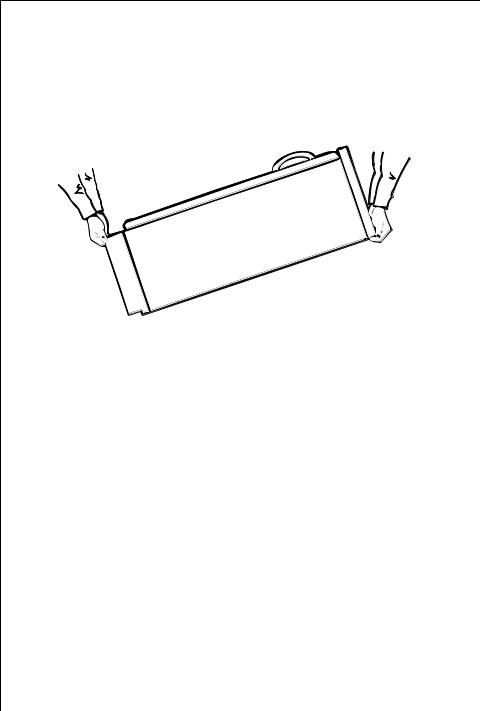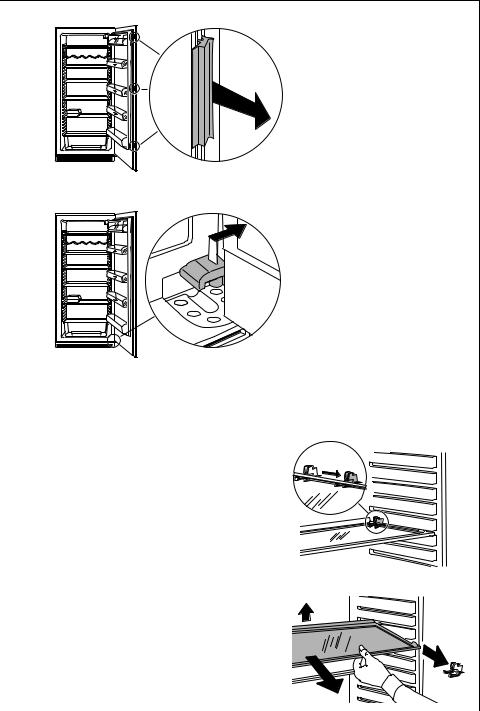AEG-Electrolux 3774-6KA, 3374-6KA, S3873-6KA User Manual
ÖKO_SANTO SUPER
Electronic Refrigerators
Operating Instructions
818 17 78-00/5

Dear customer,
Before placing your new refrigerator into operation please read these operating instructions carefully. They contain important information for safe use, for installation and for care of the appliance.
Please keep these operating instructions for future reference. Pass them on to possible new owners of the appliance.
These operating instructions are for use with several technically comparable models with varying accessories. Please observe the notes which apply to your model.
1 Notes which are important for your safety or for the proper functioning of the appliance are stressed with a warning triangle and/or with signal words (Warning!, Caution!, Important!). Please observe the following carefully.
01. This symbol and numbered instructions guide you step by step in the operation of the appliance.
2. .....
3 Supplementary information regarding operation and practical uses of the appliance appear after this symbol.
2 Tips and notes concerning economical and environmentally sound use of the appliance are marked with the cloverleaf.
Explanations of the technical terminology used in the operating instructions can be found at the end in the section "Technical Terminology".
The operating instructions contain instructions for the correction of possible malfunctions by the user in the section "Something not working". If these instructions should not be sufficient, please contact your local AEG Service Force Centre.
Printed on paper manufactured with environmentally sound processes.
he who thinks ecologically acts accordingly ...
2 |
818 17 78-00/5 |

Contents |
|
Important Safety Instructions . . . . . . . . . . . . . . . . . . . . . . . . . . . . . . . . . . . . |
5 |
Environmental Information . . . . . . . . . . . . . . . . . . . . . . . . . . . . . . . . . . . . . . |
7 |
Packaging . . . . . . . . . . . . . . . . . . . . . . . . . . . . . . . . . . . . . . . . . . . . . . . . . . . . . . |
7 |
Old Appliances . . . . . . . . . . . . . . . . . . . . . . . . . . . . . . . . . . . . . . . . . . . . . . . . . . |
7 |
Appliance Transport . . . . . . . . . . . . . . . . . . . . . . . . . . . . . . . . . . . . . . . . . . . . |
8 |
Before Use . . . . . . . . . . . . . . . . . . . . . . . . . . . . . . . . . . . . . . . . . . . . . . . . . . . . . |
8 |
Packaging . . . . . . . . . . . . . . . . . . . . . . . . . . . . . . . . . . . . . . . . . . . . . . . . . . . . . . |
8 |
Installation . . . . . . . . . . . . . . . . . . . . . . . . . . . . . . . . . . . . . . . . . . . . . . . . . . . . |
10 |
Installation Location . . . . . . . . . . . . . . . . . . . . . . . . . . . . . . . . . . . . . . . . . . . . . |
10 |
The Refrigerator needs Ventilation . . . . . . . . . . . . . . . . . . . . . . . . . . . . . . . . . |
11 |
Appliance Alignment . . . . . . . . . . . . . . . . . . . . . . . . . . . . . . . . . . . . . . . . . . . . . |
11 |
Electrical Connection . . . . . . . . . . . . . . . . . . . . . . . . . . . . . . . . . . . . . . . . . . . . |
12 |
Changing over the Door Hinges . . . . . . . . . . . . . . . . . . . . . . . . . . . . . . . . . . |
13 |
Appliance Description . . . . . . . . . . . . . . . . . . . . . . . . . . . . . . . . . . . . . . . . . . . |
15 |
View of Appliance . . . . . . . . . . . . . . . . . . . . . . . . . . . . . . . . . . . . . . . . . . . . . . . |
15 |
Control Panel . . . . . . . . . . . . . . . . . . . . . . . . . . . . . . . . . . . . . . . . . . . . . . . . . . . |
16 |
Buttons for Adjusting the Temperature . . . . . . . . . . . . . . . . . . . . . . . . . . . . . |
16 |
Temperature Display . . . . . . . . . . . . . . . . . . . . . . . . . . . . . . . . . . . . . . . . . . . . . |
17 |
Prior to Initial Start-Up . . . . . . . . . . . . . . . . . . . . . . . . . . . . . . . . . . . . . . . . . |
17 |
Initial Start-Up . . . . . . . . . . . . . . . . . . . . . . . . . . . . . . . . . . . . . . . . . . . . . . . . . |
17 |
Temperature Adjustment . . . . . . . . . . . . . . . . . . . . . . . . . . . . . . . . . . . . . . . . |
18 |
FAST CHILL . . . . . . . . . . . . . . . . . . . . . . . . . . . . . . . . . . . . . . . . . . . . . . . . . . . . |
18 |
Switching the Appliance off . . . . . . . . . . . . . . . . . . . . . . . . . . . . . . . . . . . . . |
19 |
Opening the Door . . . . . . . . . . . . . . . . . . . . . . . . . . . . . . . . . . . . . . . . . . . . . . |
19 |
Interior Accessories . . . . . . . . . . . . . . . . . . . . . . . . . . . . . . . . . . . . . . . . . . . . . |
20 |
Storage Shelves . . . . . . . . . . . . . . . . . . . . . . . . . . . . . . . . . . . . . . . . . . . . . . . . . |
20 |
Variable Inner Door . . . . . . . . . . . . . . . . . . . . . . . . . . . . . . . . . . . . . . . . . . . . . . |
20 |
Fruit and Vegetable Drawer . . . . . . . . . . . . . . . . . . . . . . . . . . . . . . . . . . . . . . . |
20 |
Bottle Rack . . . . . . . . . . . . . . . . . . . . . . . . . . . . . . . . . . . . . . . . . . . . . . . . . . . . . |
21 |
Bottle Holder . . . . . . . . . . . . . . . . . . . . . . . . . . . . . . . . . . . . . . . . . . . . . . . . . . . |
21 |
818 17 78-00/5 |
3 |

Contents
Correct Storage . . . . . . . . . . . . . . . . . . . . . . . . . . . . . . . . . . . . . . . . . . . . . . . . 22
Defrosting . . . . . . . . . . . . . . . . . . . . . . . . . . . . . . . . . . . . . . . . . . . . . . . . . . . . . 22 The Refrigerator is defrosted automatically . . . . . . . . . . . . . . . . . . . . . . . . . . 22
Cleaning and Maintenance . . . . . . . . . . . . . . . . . . . . . . . . . . . . . . . . . . . . . . 23
Energy Saving Tips . . . . . . . . . . . . . . . . . . . . . . . . . . . . . . . . . . . . . . . . . . . . . . 24
What to do if ... . . . . . . . . . . . . . . . . . . . . . . . . . . . . . . . . . . . . . . . . . . . . . . . . 25 Correcting Malfunctions . . . . . . . . . . . . . . . . . . . . . . . . . . . . . . . . . . . . . . . . . . 25 Replace Light Bulb . . . . . . . . . . . . . . . . . . . . . . . . . . . . . . . . . . . . . . . . . . . . . . . 27
Noises during Operation . . . . . . . . . . . . . . . . . . . . . . . . . . . . . . . . . . . . . . . . . 28
Regulations, Standards, Guidelines . . . . . . . . . . . . . . . . . . . . . . . . . . . . . . . 28
Technical Terminology . . . . . . . . . . . . . . . . . . . . . . . . . . . . . . . . . . . . . . . . . . 29
Customer Service . . . . . . . . . . . . . . . . . . . . . . . . . . . . . . . . . . . . . . . . . . . . . . . 31
4 |
818 17 78-00/5 |

1 Important Safety Instructions
The safety aspects of our refrigerators comply with accepted technical standards and the German Appliance Safety Law. Nevertheless, we consider it our obligation to make you aware of the following safety information:
Intended use
•The refrigerator is intended for use in the home. It is suitable for the storing of food at low temperature. If the appliance is used for purposes other than those intended or used incorrectly, no liability can be accepted by the manufacturer for any damage that may be caused.
•Alterations or changes to the refrigerator are not permitted for reasons of safety.
•If you use the refrigerator in a commercial application or for purposes other than the cooling of foods, please observe all valid legal regulations for your application.
Prior to initial start–up
•Check the refrigerator for transport damage. Under no circumstance should a damaged appliance be plugged in! In the event of damage, please contact your retailer.
Refrigerant
The refrigerant isobutane (R600a) is contained within the refrigerant circuit of the appliance, a natural gas with a high level of environmental compatibility, which is nevertheless flammable.
•Warning - During transportation and installation of the appliance, be certain that none of the components of the refrigerant circuit become damaged.
•If the refrigerant circuit should become damaged:
–avoid open flames and sources of ignition;
–thoroughly ventilate the room in which the appliance is situated.
Safety of children
•Packaging (e.g. wraps, polystyrene) can be dangerous for children. There is a risk of suffocation! Keep packaging material away from children!
818 17 78-00/5 |
5 |

Important Safety Instructions
•Please make old appliances unusable prior to disposal. Pull out the mains plug, cut off the mains cable, break or remove spring or bolt catches, if fitted. By doing this you ensure that children cannot lock themselves in the fridge when playing (there is risk of suffocation!) or get themselves into other dangerous situations.
•Often children cannot recognise the hazards present in household appliances. It is therefore important that you ensure adequate supervision and never let children play with the appliance!
Daily Operation
•Containers with flammable gases or liquids can leak at low temperatures. There is a risk of an explosion! Do not store any containers with flammable materials such as, for example, spray cans, fire extinguisher refill cartridges etc in the refrigerator.
•Warning - Do not operate any electrical appliances in the refrigerator (e.g. electric ice cream makers, mixers etc.) unless they have been authorised by the manufacturer.
•Warning - In order not to impair the function of the appliance, never cover or obstruct the ventilation openings.
•Warning - Do not use any mechanical devices or other artificial means to speed up defrosting unless they are recommended by the manufacturer.
•Before cleaning the appliance, always switch off the appliance and unplug it, or pull the house fuse or switch off the circuit breaker.
•When unplugging always pull the plug from the mains socket, do not pull on the cable.
In case of malfunction
•If the a malfunction occurs on the appliance, please look first in the "What to do if ..." section of these instructions. If the information given there does not help, please do not perform any further repairs yourself.
•Refrigerators may only be repaired by qualified service engineers. Improper repairs can give rise to significant hazards. If your appliance needs repairing, please contact your local AEG Service Force Centre.
6 |
818 17 78-00/5 |

Environmental Information
Packaging
All transit packaging materials are environmentally compatible and can be reused. Wood is un-treated. The plastics can be recycled and are identified as follows:
>PE< for polyethylene, e.g. the outer covering and the bags in the interior.
>PS< for polystyrene foam, e.g. the pads, which are pure hydrocarbon compounds and can be recycled.
The carton parts are made from recycled paper. Please dispose of the packaging with due care for the environment.
Old Appliances
For environmental reasons, refrigeration appliances must be disposed of properly. This applies to your old appliance, and - at the end of its service life - for your new appliance as well.
1 Warning! Before disposing of old appliances make them inoperable. Remove plug from mains, sever the power cable, remove or destroy any snap or latch closures. This eliminates the danger that playing children lock themselves into the appliance (danger of suffocation!) or place themselves into other life-endangering situations.
When disposing of your old appliance:
•The appliance may not be disposed of with domestic waste or bulky refuse.
•The refrigerant circuit, especially the heat exchanger at the back of the appliance, may not be damaged.
•Information concerning collection schedules or locations can be obtained from the local disposal authorities or town hall.
818 17 78-00/5 |
7 |

Appliance Transport
Two persons are required for transport of the appliance. There are two recessed handles at the front of the base and at the back of the appliance at the top for improved gripping.
01. Grip the appliance with the recessed handles positioned as in the drawing, and transport the appliance.
2.In order to push the appliance into its final position, press carefully at the top of the door and tip the appliance back slightly. The weight is thus transferred to the back wheels and the appliance can be easily pushed.
Before Use
Packaging
01. Remove all adhesive tape and packaging from the interior of the appliance.
3 Any remnants of adhesive can be removed with white spirit.
2. Remove the transport protection pieces and pull off the adhesive tape.
8 |
818 17 78-00/5 |

Before Use
3.Wash the inside of the appliance with lukewarm water with a little bicarbonate of soda added (5 ml to 0.5 litre of water). Do not use soap or detergent as the smell may linger. Dry the appliance thoroughly.
Remove the transport fittings from the storage shelves:
4. Slide the fittings securing the shelf forward to the thicker section on the edge of the storage shelf.
5. Slide the storage shelf far enough forward so that it can be hinged downwards and the fittings can be removed from the guides.
818 17 78-00/5 |
9 |

Installation
Installation Location
The appliance should be installed in a well ventilated, dry room. Energy use and efficient performance of the appliance is affected by the ambient temperature.
The appliance should therefore
–not be exposed to direct sunlight;
–not be installed next to radiators, cookers or other sources of heat;
–only be installed at a location whose ambient temperature corresponds to the climate classification, for which the appliance is designed.
The climate classification can be found on the rating plate, which is located at the left on the inside of the appliance.
The following table shows which ambient temperature is correct for each climate classification:
Climate classification |
for an ambient temperature of |
SN |
+10 to +32 °C |
N |
+16 to +32 °C |
ST |
+18 to +38 °C |
T |
+18 to +43 °C |
|
|
If installation next to a source of heat is unavoidable, the following minimum clearances must be maintained at the sides of the appliance:
–for electric cookers 3 cm;
–for oil and coal fired ranges 30 cm.
If these clearances cannot be maintained a heat insulating pad is required between the cooker and the refrigeration appliance.
10 |
818 17 78-00/5 |
